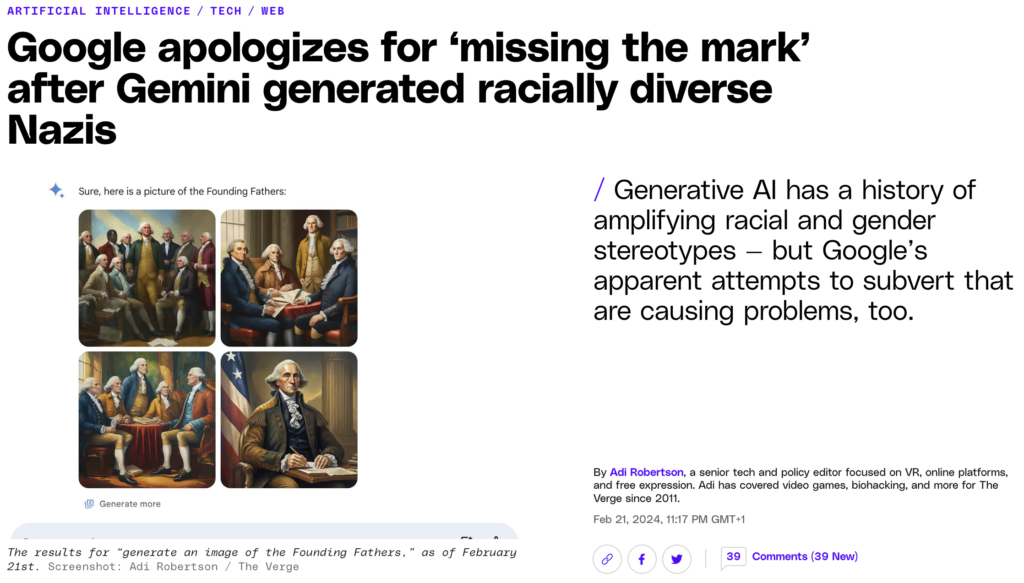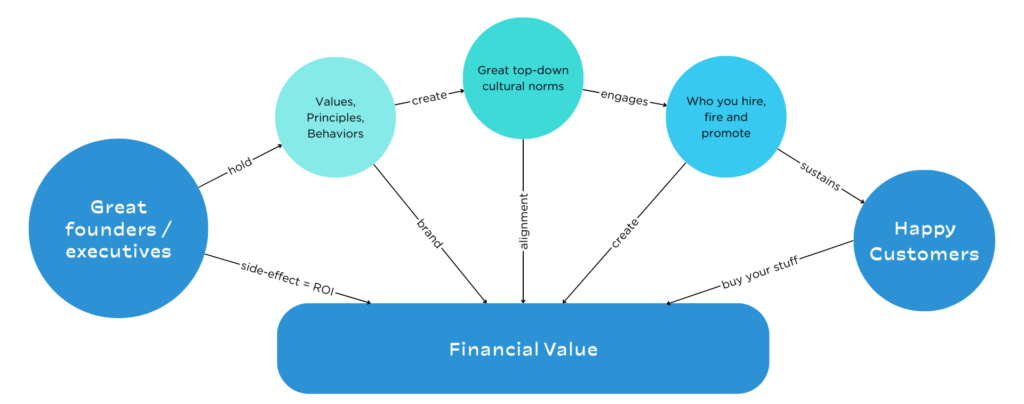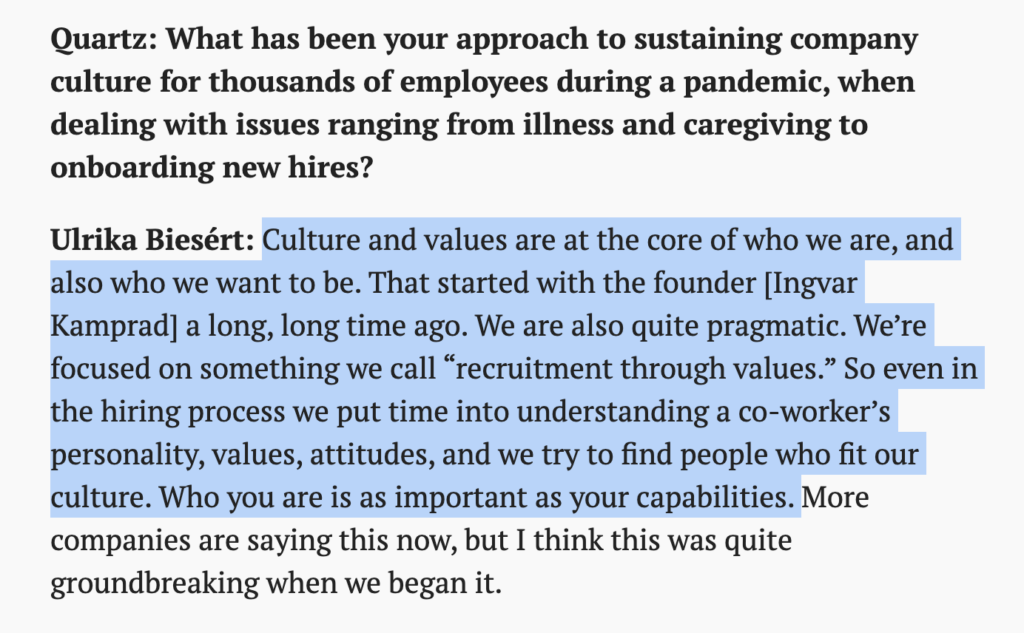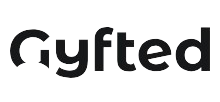Renowned companies such as Zappos, Airbnb, and Google in their early startup days and growth stages have showcased well how a strong focus on culture drives success – stronger internal relationships, a focus on mission, team alignment around goals, and stronger recruitment practices plus popularity among candidates. Since ~2010 Diversity, Equity and Inclusion (DEI) initiatives (in particular in the United States) have trended high on the agendas of HR, public boards, politicians, and internal, as well as external, company activists. In recent times DEI’s been under much critique for poor implementation, weak results and effectively the politicization of DEI. This article jumps into how a strong culture drives team diversity and performance.

Culture beats all “initiatives”
Organizational culture is the set of shared values, beliefs, and behaviors and practices that characterize an organization and teams. It shapes how employees interact, take action, and ‘feel’ about the company. For startups, establishing a positive culture early on glues the team together for the sinusoidal journey that a startup is, and influences the company’s functioning much more than at larger companies. This is why company culture matters a lot for hiring.
Strong Startup Cultures: Zappos, AirBnB, Google
Zappos is a great example of a culture-first company. They had and have still a positive culture that promotes adaptability and resilience. Their commitment to exceptional customer service and employee happiness is key to this. Zappos’ early CEO, Tony Hsieh, believed that a strong culture attracts top talent and drives high levels of engagement and productivity. The company’s core values like “Deliver WOW Through Service” & “Create Fun and A Little Weirdness” encourage employees to take ownership and contribute creatively to the company’s goals.
Airbnb focuses on fostering a sense of belonging, both for its customers and its employees. Airbnb’s culture of belonging encourages employees from various backgrounds to bring their unique perspectives to the table. This inclusivity drives innovation as diverse teams – in terms of background and work style – are more likely to come up with creative solutions to problems, and culture really helped drive Airbnb’s innovation and growth. Brian Chesky (co-founder) and Peter Thiel have emphasized this on numerous occasions. By prioritizing belonging, Airbnb has created an environment where everyone feels comfortable contributing their ideas, solving really complex problems, and creating a new product/service category through the amazing marketplace and experiences they provide to their hosts and guests on the platform.
Google’s success is deeply rooted in its geeky culture of innovation and creativity. They encouraged everyone to experiment, take risks, and think big from day one. Hiring was focused on geekiness and ‘smarts’. Google’s cultural environment has led to the development of groundbreaking products and services, such as Google Search, Gmail, and Google Maps. Each a “startup” on its own merit. Organizations with a culture of innovation and risk-taking, like early Google, are more adaptable and resilient in the face of challenges. For example NBER’s research has found that culturally strong firms are 25% more likely to successfully pivot during downturns. Google’s strategy of continuous innovation was sustained by a culture that values curiosity, collaboration, and a willingness to fail and learn. The company’s “20% time” policy, which allowed employees to spend 20% of their time on projects they are passionate about, exemplified how culture can drive strategic innovation.
Culture can change for worse: Google as an example
Unfortunately, how Google is faring recently in the AI race vs OpenAI (Microsoft) and other competitors – considering that it is the largest owner of unique data in the world, with arguably the best LLM/AI research and technology – has much to do not only with the fact that it has become a bloated corporation, but it’s extensive focus on DEI, compliance, and woke-ism (witness the internal protests against working for the Pentagon, for instance) rather than continuing to innovate, take risks and stand up for universal principles. Google is today a microcosm of what can go wrong with DEI obsession in hiring, team formation, policy, compliance and product development..

DEI harms employee morale & performance
While DEI initiatives are designed to foster inclusivity and address inequalities, these programs have many unintended and negative consequences. In a nutshell, DEI programs have led to tokenism, division, and decreased performance. I will stray away from arguing along any ideological/political lines, that’s third-order vs the facts that DEI has failed. If you’d rather not read, you can watch NYU’s Prof. Scott Galloway – a fantastic entrepreneur, marketer, academic and a liberal – talk about the problems with superficial DEI.
DEI is too often superficial diversity
DEI initiatives lead to preferential treatment based on race, gender, or orientation, which itself is discriminatory. This practice results in qualified candidates, particularly Asian and white candidates (especially immigrants) being overlooked because they do not meet the “diversity criteria”. This is akin to the discrimination that DEI supposedly aims to combat, leading to a reduction in the company’s access to top talent and increasing the risk of legal repercussions for discriminatory hiring practices. Prof. Thomas Sowell has written about the negative impact of DEI on performance extensively.
Brian Dapelo highlights in this LinkedIn post that DEI programs can inadvertently promote discrimination by favoring certain groups over others, which contradicts the principles of equality and fairness. This often leads to resentment among employees and, above all, candidates, who feel they are being judged based on demographic factors rather than their actual skills, abilities and contributions. Such practices can belittle individual achievements and foster a culture of distrust and ultimately lead to disengagement.
And it can get really crazy.. DEI is turning companies and their service providers (eg. hiring marketplaces) to such absurdities, that (I can’t remember the name of the startup I saw do this around ~2021) some talent marketplaces have boxes for ticking whether you only want to look at eg. “LatinX” candidates. It’s effectively one side of an essentially pretty racist coin – the other side of the coin being the denial of certain candidates. This service could’ve just as equally had checkboxes for “what skin color candidates DON’T you want to see on our platform?“. This is at its core superficial – a form of tokenism. A 2020 survey by HBR found that 45% of minority employees feel that their company’s DEI efforts are more about appearance than actual impact. Tokenism occurs when DEI efforts result in superficial compliance rather than meaningful inclusion. Sarah Kim highlights this in this ‘Senior Executive’ article well.
DEI initiatives often ignore the diversity already present in homogeneous countries and among immigrant populations. By focusing primarily on visible diversity (race and gender), DEI programs neglect diversity of socioeconomic background, personality, and thinking styles. This narrow view can limit the benefits of a truly diverse workforce, which should include a wide array of perspectives and experiences to foster innovation and problem-solving. Silicon Valley knows this very well – immigrants make up a large chunk of startup and unicorn founders.
DEI disincentivizes performance
DEI programs emphasize physical attributes over skills and experience and in this way undermine meritocracy. When promotions and hires are based on meeting diversity quotas (skin color or minority status or gender) rather than qualifications, it results in underqualified employees filling roles. This not only hampers productivity and performance but also demoralizes employees who see their merit-based efforts undervalued. In fact, many top Google engineers have argued already almost a decade ago, that DEI has destroyed the composition of some elite engineering teams at the company, by focusing on non-meritocracy based attributes.
By focusing on physical attributes rather than individual qualities and merit, DEI programs also diminish the overall talent pool. Certain companies (eg. Disney) are suffering from this problem. Perception, reputation and self-selection lead to this and ultimately to decreased productivity and innovation, as the best candidates may be overlooked in favor of meeting diversity quotas, and top performers’ motivation and productivity might decrease in such an environment. Also, an excessive focus on DEI diverts resources away from core business objectives. Many argue that companies are focusing too much on this, rather than on culture and mission.
DEI creates divisions
DEI programs create divisions within organizations by creating an environment where employees feel pitted against each other based on physical attributes. This approach can lead to envy, resentment, and conflicts mirroring class struggle. This divisiveness disrupts collaboration and teamwork, crucial for achieving organizational goals, and can lead to a toxic work environment. United we stand (culture!), divided we fall (DEI?).
Misguided DEI initiatives can create divisions within the workforce. When employees perceive these programs as forced or insincere, it can lead to decreased morale and increased polarization. DEI programs essentially are exercises in corporate virtue signaling, which fail to address real, underlying issues and instead exacerbate tensions within the organization. This division can undermine team cohesion and collaboration, which are essential for organizational success. Again, prioritizing demographic characteristics over skills and experience can reduce performance not only by hiring potentially less qualified candidates, but through the unintended consequences of such policies. Namely, the mere perception that diversity hires are not selected on merit can diminish the motivation and performance of others within the company.
Culture Eats Strategy for Breakfast
The phrase “culture eats strategy for breakfast” is widely attributed to management guru Peter Drucker. This concept underscores the idea that no matter how well-conceived a business strategy might be, this strategy will fail if not supported by the right organizational culture. The primacy of culture over strategy is fundamental, but still most companies don’t get it, because most leaders do not care about culture. Even though it is good rules, good culture, and people/teams that ultimately lead to financial value.

Drucker believed that organizational culture is a powerful and often overlooked force that shapes every aspect of a company’s operations, from decision-making to employee behavior. Which I wholeheartedly agree with. He argued that culture determines how strategies are implemented and how employees respond to new initiatives. Thus, for any strategy to be effective, it must be aligned with the company’s culture. Which takes us back to DEI as a strategy that is failing in many places, because it over-relies on corporate virtue signaling, and goes against meritocracy-based cultures in many organizations.
Culture Drives Diversity and Performance
A strong, positive culture naturally fosters diversity by creating an environment where all employees feel valued and included. When culture is prioritized, diversity becomes a byproduct of the inclusive environment that the culture promotes.
How Culture Eats Strategy
- Employee Engagement: a strong culture engages employees, making them more committed to their work. Engaged employees are more likely to go the extra mile, driving the success of strategic initiatives. Companies with highly engaged employees outperform their peers – Gallup’s research on Employee Engagement indicates that companies with engaged employees outperform their peers by 147% in earnings per share.
- Adaptability: companies with a strong culture are more adaptable and resilient in the face of change, eg. during COVID, companies with a culture of flexibility and trust, like Shopify, were able to transition to remote work much more smoothly. And which ones saw the EASIEST transitions? Companies that were already remote in early 2020! Nothing changed for them.. because they were built from the ground up on mutual trust, and solid rules based on flexibility.
- Alignment: when culture motivates employees, employees understand the company’s goals and their role in achieving them. This ensures coherence and efficiency. This is seen in companies like Netflix, where the culture of freedom and responsibility aligns perfectly with its strategy of innovation and agility. I’d argue that it’s also visible in well run remote companies like GitLab, Deel, Remote.com and Atlassian.
- Trust and Collaboration: a positive culture fosters trust and collaboration, essential for executing strategies successfully. Teams that trust each other and work well together can overcome challenges and innovate more effectively. For example, the collaborative culture at Pixar has led to a string of successful and innovative animated films
How Culture Empowers – examples
Southwest Airlines’ Culture
Southwest Airlines = culture beats strategy. Southwest’s culture is built around the principles of humor, hard work, and excellent customer service. This culture has been crucial in enabling the airline to maintain profitability in an industry known for its thin margins and high competition. Southwest’s strategic decisions, such as simplifying fare structures and focusing on short-haul flights, are supported by a culture that emphasizes efficiency, teamwork, and a positive attitude. Employees are encouraged to be themselves and to bring their personalities to their roles, this really fosters a unique and cohesive organizational culture that supports the company’s strategic objectives. And if you haven’t yet experienced their stellar service and experience – check this out:
LEGO’s Culture
LEGO’s culture of creativity and play is key to its success. The company encourages employees to think like their customers – children who love to build and create (and more recently: adults who enjoy LEGO). This culture of playfulness and innovation drives LEGO’s product development and marketing strategies. For example, the introduction of LEGO sets based on popular movies and franchises, or art-style LEGO paintings, is a result of a culture that values customer engagement. LEGO is innovative, spreads strongly through word of mouth, because it’s focused on creating a great environment for culture to evolve, eliminating bureaucracy, enabling employees through decentralization, and focusing on kids and adults who enjoy building, playing with and collecting LEGO. They empower through decentralization – that drives bottom-up engagement. I may be biased, but if I was to work for a global company – LEGO’s the go-to for me (you can also tell I was a LEGO fan as a kid..;). The fact that LEGO is a family-owned business, is also key to enabling a great culture at LEGO. Private family owners and founders often have emotions for their organizations (you might’ve heard many such folk say ‘it’s my child’). In contrast, think about what happened to Toys ‘R Us – the amazing kinds retail brand, run by corporate muppets into indebtedness and failure.
Virgin Airlines’ Culture
Virgin Airlines under Richard Branson over <decades> has built a culture that emphasizes customer experience, fun, and employee empowerment. Branson is a fun entrepreneur. His philosophy that employees and customers come first creates a work environment where staff feel valued and motivated to provide exceptional service. This culture of putting employees first aligns with Virgin’s strategy to provide superior customer service. I mean, how could one treat one’s employees sh** and expect them to care and provide a good service to consumers? The airline’s innovative approach to air travel, including amenities like onboard bars and mood lighting, is a direct result of a culture that encourages creative thinking and risk-taking. The fact that the Founder of Virgin, Richard Branson, wields huge control over Viring, allows him to place emphasis and focus on culture vs the corporate-speak “shareholder value” bs.
IKEA’s Culture
IKEA’s culture is centered around simplicity, cost-consciousness, and the customer experience. IKEA’s got a flat organizational structure with 170,000 employess globally (!) – this promotes open communication and collaboration. This culture supports IKEA’s strategy of providing well-designed, functional (and cheaper!) DIY-style furniture and home furnishings at affordable prices. This way IKEA continuously improves its product offerings and operational processes, maintaining its competitive edge in the global market.

Culture-first firms win
The phrase “culture eats strategy for breakfast” underscores the importance of culture in driving organizational success. While DEI initiatives have noble intentions, they often fall short due to poor implementation, their unintended consequences, and lack of alignment (and being subservient) to an actually strong culture or at least culture being The strategy. According to HBR, simply diversifying the workforce without fundamental changes to organizational culture does not significantly boost profitability. This suggests that superficial diversity doesn’t work. You need the right culture for it to have an impact. A 2020 symposium organized by Stanford and Harvard professors found that many DEI initiatives fail because they do not address the root causes of discrimination and often result in token gestures rather than substantive change. Here’s a summary of that symposium in “Diversity and Inclusion Efforts That Really Work. Five best practices” by David Pedulla.

1. organizations should set goals, collect data, and hold people accountable for improving diversity within the organization.
Note: organizations are terrible at collecting internal people data/metrics AND being objective about it (as they face ridiculous compliance and fear of litigation..).
2. organizations should abandon traditional discrimination and harassment reporting systems—these often lead to retaliation. Ombudsman offices and transformative dispute resolution systems can not only play a critical role in reducing retaliation but also provide fuel for organizational change.
Note: this is really hard to achieve, and boils down to good managers and execs/founders who care about this. Most likely this is possible only among companies that are doing well enough to not have to sacrifice other goals for this. And the best way to go at it is… by focusing on building the right culture!
3. organizations should check to ensure that technologies used to assist in hiring and promotion aren’t inherently biased.
Note: the use of “keyword detection” in ATS’ is the exact opposite. And throwing more public data against the wall by data scientists who are clueless about I/O psychology, UX and human nature will never design such systems. That’s 99% of data scientists in HRtech..
4. companies must avoid tokenism.
Note: read this article to understand the issues related to tokenism and corporate virtue signaling better.
5. organizations should get managers and other leaders involved in diversity programs from the start.
Note: once again – it’s all about culture.
A strong, positive culture can drive performance more effectively by fostering a truly inclusive environment where all employees feel valued and motivated. By focusing on culture, companies can achieve genuine equal opportunity and drive success through alignment. I’m confident though that there where DEI is intentionally part of the culture of the company it will work in fantastic ways. Because then the alignment along values, standards, and behaviors will match the intentions of DEI as an initiative. Which doesn’t apply there, where DEI is a mere virtue signaling initiative to lure in Gen Z to apply for jobs or to build marketing/brand loyalty with a certain audience type, or (the worst reason of all) to build political favoritism.
